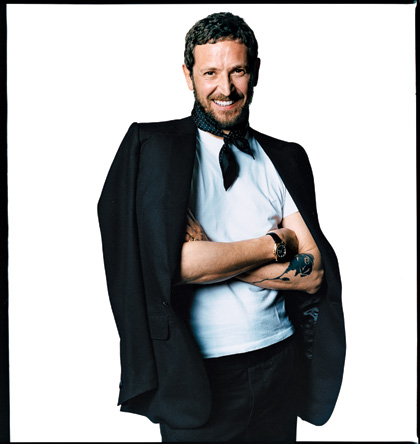 Stefano Pilati. Photograph by David Bailey. Published in Vogue, September 2004
Stefano Pilati. Photograph by David Bailey. Published in Vogue, September 2004
Stefano Pilati’s 2004 debut at Yves Saint Laurent (Brand)—hot on the heels of Tom Ford’s sensational departure from the exalted French house—was one of the most anticipated in fashion history. The debonair Italian, then a relative unknown, was the third in a string of designers-cum-dauphins charged with the seemingly impossible task of maintaining a covenant with Saint Laurent’s epic legacy while creating new codes that would give the label contemporary relevance.
“There is nothing that Saint Laurent didn’t think of first,” Pilati said, upping the ante even further.
So how did the Prada– and Ford-trained designer tackle the challenge? With stubborn individuality. In seasons of hypersexed fashion, he showed polka dots and body-enhancing, ruffled dresses that, he said, “came from a memory of Saint Laurent in the late seventies.” Many critics balked, but time proved that Pilati was simply ahead of the curve. Notable case in point: the much-copied tulip skirt, which exerted a major influence on subsequent seasons’ silhouettes. “I think what maybe people objected to was that it was quite extreme,” said Anna Wintour of Vogue. “But you need the extremes to move people’s eye.” That first collection, she said, “didn’t look like anyone else’s.”
Pilati continued to stand apart, a latter-day Don Quixote pursuing a vision of grown-up, very French elegance. The fall 2007 and 2008 collections, particularly, were considered breakthroughs for their clarity of conception and purity of form. Critics occasionally remarked, however, that his work was too reverential to the past, that it relied too heavily on Yves-isms. “To me,” he countered in 2005, “it’s simply newer to be classic than transgressive.”
Shortly before the fall collections were mounted in 2012—and after months of rumors—the Saint Laurent company announced that Pilati was stepping down. Although his tenure was broadly respected and considered a success, he had failed to reach the starry brilliance of his predecessors.
Within a few months, however, the press was abuzz again (if perhaps at a slightly lower decibel level) with the news that he would pilot the Italian menswear label Ermenegildo Zegna and its sister brand, Agnona. Those truly in the know were probably not terribly surprised that Pilati would make this Lazarus-like return: A onetime heroin addict—who got his start as a teenage usher at fashion shows in Milan—the tattooed designer is clearly a man of considerable grit. “Work is my salvation,” he once said.
Source: Voguepedia

